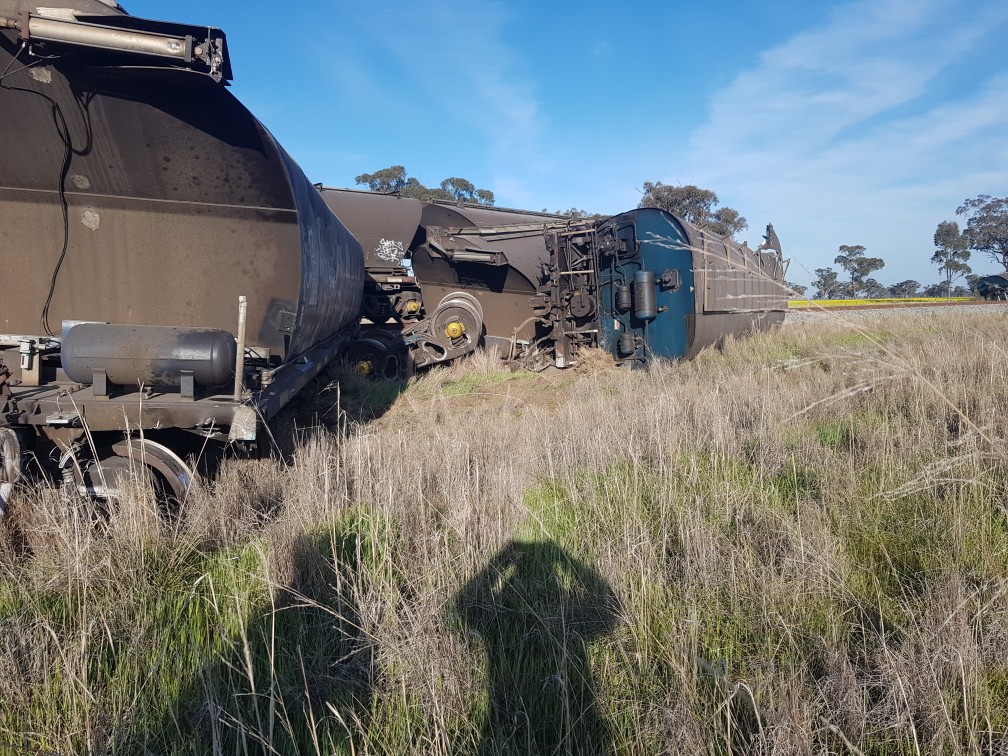
The scene of the collision between a train and a truck on Mary Gilmore Way near Bribbaree in September. Photo: Supplied.
A notorious level rail crossing near the Hilltops town of Bribbaree is being considered for a full upgrade to an active crossing with boom-gate control, Transport for NSW (TfNSW) has confirmed.
The announcement comes after the latest in a string of crashes at the Mary Gilmore Way site, when a fully loaded B-double livestock truck and a Pacific National freight train collided around 6:40 am on 26 September.
The incident, which derailed about seven rail wagons, left a truck passenger with minor injuries and caused the deaths of some livestock, led to all-day closures of both the rail line and Mary Gilmore Way.
Independent investigations remain ongoing, but TfNSW has confirmed that warning technology installed as part of a two-year safety trial was active at the time.
The Mary Gilmore Way crossing has long been regarded as a black spot by locals and truck drivers travelling between Barmedman and Grenfell.
The state-controlled road links Goldenfields Way in the Riverina to the Mid-Western Highway, forming a key freight route between the Riverina and central NSW.
READ ALSO: UPDATED: Train and stock truck collide at notorious Bribbaree level crossing
Residents say the level rail crossing is particularly dangerous due to limited visibility and heavy freight traffic running on the main line between Stockinbingal and Temora.
Previous incidents at Mary Gilmore Way include a February 2020 collision that derailed several wagons and another in December 2022, between a prime mover and a freight train, under similar circumstances. No fatalities were reported in either case.
The deadliest crash in the area occurred in February 2021, when two Grenfell men, 27-year-old Ethan Hunter and 50-year-old Mark Fenton, were killed after their truck and a freight train collided at a nearby private crossing at Eurabba Station.
The series of incidents, coupled with sustained community pressure, prompted the State Government to install flashing LED lights and advanced warning signage at the Bribbaree crossing in 2023.
The system, part of a two-year, $1.5 million statewide trial, is designed to improve driver awareness at passive crossings and supplement existing static warnings, including stop lines, stop signs and “Look for trains” notices.
The lights activate when approaching vehicles trigger sensors, alerting drivers to stop and check for trains.
NSW Minister for Regional Transport Jenny Aitchison said the trial had already provided valuable insight into driver behaviour.
“There is still a lot of work to do before the results of the trial and recommendations for potential applications can be released; however, preliminary results show the LED signage has been effective in achieving its aim of increased driver awareness and improved behaviours at passive crossings,” she said.
“A range of factors, including driver behaviour, also need to be considered as part of any interaction at a level crossing.”
Even with the trial in place, Mary Gilmore Way will be considered for a full upgrade to an active crossing with boom-gate control under TfNSW’s Level Crossing Improvement Program.
The department prioritises upgrades using the Australian Level Crossing Assessment Model (ALCAM), which incorporates safety incident data, local knowledge and risk information from rail and road managers.
Families of crash victims and local leaders say the measures have been too slow.
Ethan Hunter’s mother, Vicki Hunter, recently told the ABC she believes the LED trial is ineffective and will not save lives unless boom gates are installed.
Local MP Steph Cooke criticised the current level-crossing protections as “Band-Aid solutions” that didn’t address the underlying risks.
She highlighted high speed limits and poor visibility in early mornings, warning that accidents were likely to recur without proper active warning systems.
Ms Cooke said she had urged the minister to install boom gates and flashing lights, stressing that the safety of local residents must be prioritised.
Minister Aitchison said the NSW Government was taking a multi-pronged approach to level-crossing safety, combining lower speed limits, education campaigns, enforcement blitzes, infrastructure upgrades and technology trials.
“The NSW Government is committed to improving safety at level crossings across the state as part of our Towards Zero [deaths] efforts on NSW roads,” she said.
A recent 10-day Level Crossing Awareness and Enforcement campaign in regional NSW highlighted ongoing risks at level crossings, with 80 fines issued to motorists for ignoring signals or speeding.
Police targeted crossings in the Liverpool Plains, detecting 26 level-crossing offences and 26 speeding offences, while a further 35 motorists were penalised at four Riverina crossings around Junee and Marrar for 26 level-crossing offences and six speeding offences.
The results, said the minister, underscored the dangers of driver complacency at level crossings.
“It’s concerning that so many motorists are speeding on approach to and across level crossings and committing offences despite the presence of clearly marked highway patrol vehicles at the level crossings,” Ms Aitchison said.
“Safety is our top priority, but we all need to look out for each other to ensure everyone reaches their destination safely.”
NSW has more than 2700 public level crossings, of which about 850 remain passive.
READ ALSO: Two dead after train and B-double collide west of Young
TfNSW said trials of new technology, including a new safety system at Callaghans Lane near Quirindi, were part of a wider strategy to reduce deaths and serious injuries.
The Rail Active Crossing System (RAXS) uses modular, solar-powered, wireless technology to convert passive crossings into active ones, triggering lights, bells and advance warning signage when a train approaches.
If the system experiences a fault, it reverts to stop-sign mode.
Installation began in mid-2025, with full activation in August, and the trial will continue through mid-2026, monitoring driver behaviour and system performance.
Meanwhile, with harvest fast approaching and Inland Rail’s Stockinbingal to Parkes project nearing completion, Bribbaree locals are urging TfNSW to act quickly to upgrade the Mary Gilmore Way crossing, installing full active controls to prevent further accidents and protect both drivers and the community.
